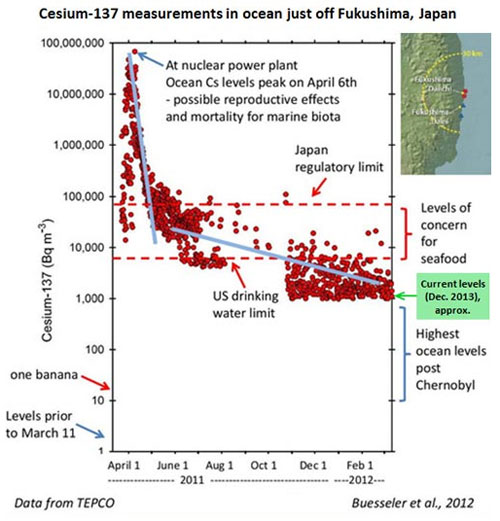
About that Fukushima Radiation... By Rep. Jonathan Kreiss-Tomkins January 13, 2014
I abandoned my studied indifference when the CBC came out with an alarmingly-titled article in November: "Radiation from Japan nuclear plant arrives on Alaska coast." I hold plenty of things against Canada, namely their 2010 Olympic men's and women's hockey teams, but the CBC, that venerable and trustworthy news institution, is not one of them. I resolved to learn more. On a trip back east, I passed through D.C. and had the good fortune to sit in on a congressional briefing by Dr. Ken Buesseler of Woods Hole Oceanographic Institution. Dr. Buesseler is America's foremost expert on oceanic radiation; his presentation was equally authoritative. The crib notes: There's no reason to move to Nebraska! We're not all gonna die — or get cancer or become mutants. The water in Japan is iffy but still safe, and the water 5,000 miles away here in Alaska, is as pure, pristine, and uncarcinogenic as the mountain streams of Southeast Alaska. When we talk Fukushima radiation, we're talking Cesium-137, a radioactive isotope which is (surprise!) extremely bad for you and extremely good at giving you cancer. Cesium-137 is measured by what are called "becquerels" (pronounced "beck-er-ELLS") per meter cubed (abbreviated Bq/m3). Right now, the water immediately off Japan registers about 2,000 Bq/m3 of Cesium-137. Consider the following: 50,000,000 Bq/m3 can cause birth defects in marine organisms. 7,400 Bq/m3 is the EPA limit for safe drinking water. There are 12 Bq of naturally occurring radiation in a banana. The natural radioactivity of the ocean is 2 Bq/m3.
The water off Japan (2,000 Bq/m3) is elevated and is hardly a best-case scenario, but it's not as though it's going to spawn Godzilla. But remember! This is radiation measured off Fukushima, Japan. It's many thousands of miles away from Alaska. I may have voted against the bill weakening cruise ship wastewater standards, but Fukushima radiation is a classic example for which the solution to pollution is in fact dilution. The vast Pacific Ocean is diluting Cesium-137 radioactivity by nearly 200 percent by the time the Kuroshio Current carries Fukushima water to our side of the Pacific. Water contaminated by the Fukushima Daiichi Nuclear Plant is forecast to arrive on the West Coast, well... right about now. Computer models predict that Fukushima-contaminated water washing up on the West Coast has between 1 Bq/m3 and 30 Bq/m3 of Cesium-137. (Remember, 7,400 Bq/m3 is the EPA limit, and 2 Bq/m3 is the naturally occurring level.) Early data gathered up and down the West Coast corroborates these predictions. To be clear: there may well be more radiation in a banana (and who doesn't love bananas?) than off our Alaska coast. As I said, there's no reason to move to Nebraska! But, we absolutely need to cautiously monitor the situation. There are legitimate reasons to be concerned about Fukushima, and the Department of Environmental Conservation should play a visible, proactive leadership role. It has not. Unchecked by fact, fear-mongering Facebook posts that make the entire Pacific Ocean look as though it's practically boiling with nuclear radiation are stirring up paranoia. Facebook is good for photos of your best friend's impossibly cute newborn baby. But for Fukushima information, take it from Dr. Buesseler of Woods Hole: the Pacific is safe and so is our seafood. Rep. Jonathan Kreiss-Tomkins
Received January 08, 2014 - Published January 13, 2014 Viewpoints - Opinion Letters:
Representations of fact and opinions in letters are solely those of the author. Your full name, city and state are required for letter publication.
|
